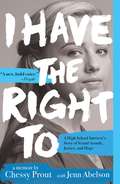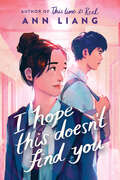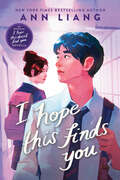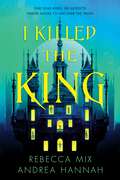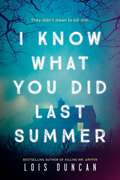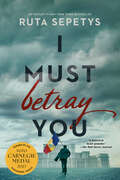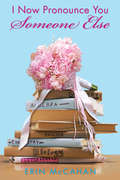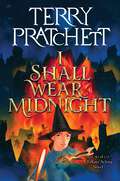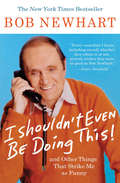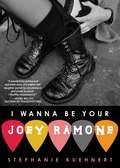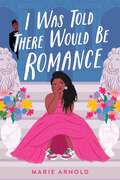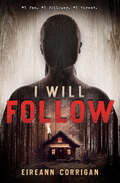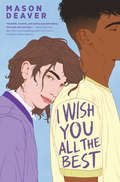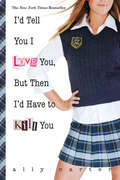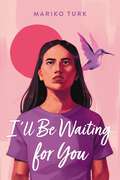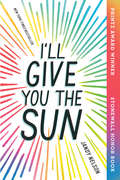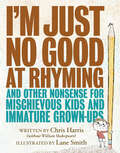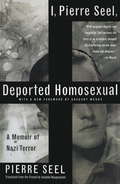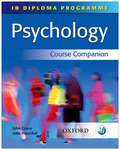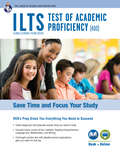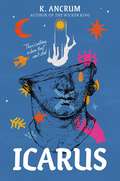- Table View
- List View
I Have the Right To: A High School Survivor's Story of Sexual Assault, Justice, and Hope
by Chessy Prout Jenn Abelson&“A bold, new voice.&” —People &“A nuanced addition to the #MeToo conversation.&” —Vice A young survivor tells her searing, visceral story of sexual assault, justice, and healing in this gutwrenching memoir.The numbers are staggering: nearly one in five girls ages fourteen to seventeen have been the victim of a sexual assault or attempted sexual assault. This is the true story of one of those girls. In 2014, Chessy Prout was a freshman at St. Paul&’s School, a prestigious boarding school in New Hampshire, when a senior boy sexually assaulted her as part of a ritualized game of conquest. Chessy bravely reported her assault to the police and testified against her attacker in court. Then, in the face of unexpected backlash from her once-trusted school community, she shed her anonymity to help other survivors find their voice. This memoir is more than an account of a horrific event. It takes a magnifying glass to the institutions that turn a blind eye to such behavior and a society that blames victims rather than perpetrators. Chessy&’s story offers real, powerful solutions to upend rape culture as we know it today. Prepare to be inspired by this remarkable young woman and her story of survival, advocacy, and hope in the face of unspeakable trauma.
I Hope This Doesn't Find You
by Ann LiangAn instant New York Times bestseller! Snarky and romantic, I Hope This Doesn't Find You is Never Have I Ever meets To All the Boys I've Loved Before if Lara Jean wrote hate emails instead of love letters.Sadie Wen is perfect on paper: school captain, valedictorian, and a "pleasure to have in class." It's not easy, but she has a trick to keep her model-student smile plastered on her face at all times: she channels all her frustrations into her email drafts. She'd never send them of course -- she'd rather die than hurt anyone's feelings -- but it's a relief to let loose on her power-hungry English teacher or a freeloading classmate taking credit for Sadie's work.All her most vehemently worded emails are directed at her infuriating cocaptain, Julius Gong, whose arrogance and competitive streak have irked Sadie since they were kids. "You're attention starved and self-obsessed and unbearably vain . . . I really hope your comb breaks and you run out of whatever expensive hair products you've been using to make your hair appear deceptively soft . . ."Sadie doesn't have to hold back in her emails, because nobody will ever read them . . . that is, until they're accidentally sent out.Overnight, Sadie's carefully crafted, conflict-free life is turned upside down. It's her worst nightmare -- now everyone at school knows what she really thinks of them, and they're not afraid to tell her what they really think of her either. But amidst the chaos, there's one person growing to appreciate the "real" Sadie -- Julius, the only boy she's sworn to hate . . . .
I Hope This Finds You (An I Hope This Doesn't Find You Novella)
by Ann LiangFrom New York Times bestselling author Ann Liang: An original I Hope This Doesn’t Find You novella, featuring Sadie’s and Julius’s POVs!Academic rivals Sadie and Julius fell in love in I Hope This Doesn’t Find You when Sadie’s email drafts were accidentally sent out. Now, their love story continues on a two-week trip to California. Sometimes, a relationship feels so special, it’s hard to believe it can work out. Featuring chapters from both Sadie’s and Julius’s perspective, they’ll have to decide if their love—and the lives they plan to build on the other side of the world—are too good to be true. New York Times bestselling author Ann Liang delivers a special sequel novella full of mutual obsession romance and fluffy humor that is pure serotonin.
I Killed the King (I Killed the King #1)
by Andrea Hannah Rebecca MixOne of Us Is Lying meets Knives Out—with beasts, murder, and magic—in this first book in a thrilling locked-room whodunnit YA fantasy duology by Andrea Hannah and New York Times bestseller Rebecca Mix.After a decade of war, the kingdoms of Avendell and Istellia have finally agreed to peace. As nobles and magic wielders from both countries arrive at remote Castle Avendell for a historic all-night masquerade to celebrate, King Costis summons an unlikely group to his chambers: the crown prince, his Istellian bride-to-be, his personal guard, a wild beast tamer, and the palace’s questionable new healer. But before Costis can reveal why he has gathered them, the castle goes dark.When the lights come back, the king is dead—murdered with the princess’s knife, in a weak spot only his guard knew of, and with venom from one of the beast tamer’s monsters lacing the blade.With no clear killer—and everyone a suspect—they make a risky pact: Tell no one until the treaty is signed. But when a winter storm seals everyone inside and someone aware of the king's untimely death begins to pick off guests one by one, the six suspects must work together to discover who killed the king . . . before one of them is next.
I Know What You Did Last Summer (Horizons Ser.)
by Lois DuncanIt was only an accident -- but it would change their lives forever. Last summer, four terrified friends made a desperate pact to conceal a shocking secret. But some secrets don't stay buried, and someone has learned the truth. Someone bent on revenge. This summer, the horror is only beginning. . . .
I Like It Like That: A Gossip Girl Novel (Gossip Girl Novel #5)
by Cecily Von ZiegesarIt's spring break and love is in the air. Or is that a blend of Chanel no. 9 and Gucci Rush? Is there a difference? Blair moves in with Serena and they're back to being best friends. But will the love-fest last or will they end up tearing out one anothers newly highlighted hair? And speaking of new, Nate is on the straight and narrow, playing Nate-in-shining-armor to his crazy new girlfriend, Georgie. But he will definitely get more than he bargained for when he, Georgie, Blair, and Serena end up hanging out together in Sun Valley, Idaho. Back in Manhattan, Jenny is spending time with a mysteriously nice new boyfriend and Dan is spending time crying in the office of the Red Letter literary journal. And Vanessa, wait, is that Vanessa shopping at Barneys with a guy in a Lacoste shirt?The long cold winter is over and the sun is finally shining along Fifth Avenue. The trees are in bloom and NYC's most fabulous are ready for a truly outrageous vacation!
I Love You So Mochi
by Sarah KuhnPerfect for fans of Jenny Han and Kasie West, I Love You So Mochi is a delightfully sweet and irrepressibly funny novel from accomplished author Sarah Kuhn."As sweet and satisfying as actual mochi... a tender love story wrapped up in food, fashion, and family. I gobbled it up." -- Maurene Goo, author of The Way You Make Me FeelKimi Nakamura loves a good fashion statement.She's obsessed with transforming everyday ephemera into Kimi Originals: bold outfits that make her and her friends feel like the Ultimate versions of themselves. But her mother disapproves, and when they get into an explosive fight, Kimi's entire future seems on the verge of falling apart. So when a surprise letter comes in the mail from Kimi's estranged grandparents, inviting her to Kyoto for spring break, she seizes the opportunity to get away from the disaster of her life.When she arrives in Japan, she's met with a culture both familiar and completely foreign to her. She loses herself in the city's outdoor markets, art installations, and cherry blossom festival -- and meets Akira, a cute aspiring med student who moonlights as a costumed mochi mascot. And what begins as a trip to escape her problems quickly becomes a way for Kimi to learn more about the mother she left behind, and to figure out where her own heart lies.In I Love You So Mochi, author Sarah Kuhn has penned a delightfully sweet and irrepressibly funny novel that will make you squee at the cute, cringe at the awkward, and show that sometimes you have to lose yourself in something you love to find your Ultimate self.
I Miss You, I Hate This
by Sara SaediFive Feet Apart meets Kate in Waiting in this timely story of two best friends navigating the complexities of friendship while their world is turned upside down by a global pandemic. The lives of high school seniors Parisa Naficy and Gabriela Gonzales couldn't be more different. Parisa, an earnest and privileged Iranian American, struggles to live up to her own impossible standards. Gabriela, a cynical Mexican American, has all the confidence Parisa lacks but none of the financial stability. She can't help but envy Parisa's posh lifestyle whenever she hears her two moms argue about money. Despite their differences, as soon as they met on the first day of freshman year, they had an "us versus the world" mentality. Whatever the future had in store for them—the pressure to get good grades, the litany of family dramas, and the heartbreak of unrequited love—they faced it together. Until a global pandemic forces everyone into lockdown. Suddenly senior year doesn't look anything like they hoped it would. And as the whole world is tested during this time of crisis, their friendship will be, too. With equal parts humor and heart, Parisa's and Gabriela's stories unfold in a mix of prose, text messages, and emails as they discover new dreams, face insecurities, and confront their greatest fears.
I Must Betray You
by Ruta Sepetys#1 New York Times Bestseller and winner of the Carnegie Medal!A gut-wrenching, startling historical thriller about communist Romania and the citizen spy network that devastated a nation, from the #1 New York Times bestselling, award-winning author of Salt to the Sea and Between Shades of Gray.Romania, 1989. Communist regimes are crumbling across Europe. Seventeen-year-old Cristian Florescu dreams of becoming a writer, but Romanians aren&’t free to dream; they are bound by rules and force.Amidst the tyrannical dictatorship of Nicolae Ceaușescu in a country governed by isolation and fear, Cristian is blackmailed by the secret police to become an informer. He&’s left with only two choices: betray everyone and everything he loves—or use his position to creatively undermine the most notoriously evil dictator in Eastern Europe.Cristian risks everything to unmask the truth behind the regime, give voice to fellow Romanians, and expose to the world what is happening in his country. He eagerly joins the revolution to fight for change when the time arrives. But what is the cost of freedom?Master storyteller Ruta Sepetys is back with a historical thriller that examines the little-known history of a nation defined by silence, pain, and the unwavering conviction of the human spirit.Praise for I Must Betray You:&“As educational as it is thrilling...[T]he power of I Must Betray You [is] it doesn&’t just describe the destabilizing effects of being spied on; it will make you experience them too.&” –New York Times Book Review&“A historical heart-pounder…Ms. Sepetys, across her body of work, has become a tribune of the unsung historical moment and a humane voice of moral clarity.&” –The Wall Street Journal * "Sepetys brilliantly blends a staggering amount of research with heart, craft, and insight in a way very few writers can. Compulsively readable and brilliant." –Kirkus Reviews, starred review* "Sepetys once again masterfully portrays a dark, forgotten corner of history." –Booklist, starred review* "Sepetys&’s latest book maintains the caliber readers have come to expect from an author whose focus on hidden histories has made her a YA powerhouse of historical fiction…Sepetys is a formidable writer, and her stories declare the need to write about global issues of social injustice. For that reason and her attention to detail, this is a must-read." –School Library Journal, starred review* "Cristian&’s tense first-person narrative foregrounds stark historical realities, unflinchingly confronting deprivations and cruelty while balancing them with perseverance and hope as Romania hurtles toward political change." –Publishers Weekly, starred review&“Sepetys keeps readers riveted to this vivid, heartbreaking and compelling novel, locked into every meticulously researched detail. I Must Betray You demands a full investment from its audience--through poetic writing, sympathetic characters, revolutionary plot and pacing, it grips the heart and soul and leaves one breathless.&” –Shelf Awareness, starred review"A master class in pacing and atmosphere." –BookPage
I Now Pronounce You Someone Else
by Erin McCahanThe teen-girl fascination with weddings comes to fiction in this hilarious debut, as 17-year-old Bronwen Oliver plots her escape from her family . . . by marrying into someone else's.Here Comes the Bride -- If She Can Pass Chemistry.Seventeen-yaer-old Bronwen Oliver has a secret: She's really Phoebe, the lost daughter of the loving Lilywhite family. That's the only way to explain her cold, manipulative mother, distant stepfather, and good-for-nothing brother: Bronwen must have been switched at birth, and she can't wait to get back to her real family.Then she meets Jared. He's sweet, funny, everything she wants - and he has the family Bronwen has always wanted too. When he proposes fourth months after they meet, she says yes. But as the wedding day approaches, Bronwen begins to wonder if Jared is truly what she needs. And if he's not, she has to ask: What would Phoebe Lilywhite do?
I Shall Wear Midnight (Tiffany Aching #4)
by Terry PratchettWinner of the Andre Norton Award for Young Adult Science Fiction and FantasyBy the beloved and bestselling grandmaster of fantasy, Sir Terry Pratchett, this is the fourth in a series of Discworld novels starring the young witch Tiffany Aching.As the witch of the Chalk, Tiffany Aching performs the distinctly unglamorous work of caring for the needy. But someone—or something—is inciting fear, generating dark thoughts and angry murmurs against witches. Tiffany must find the source of unrest and defeat the evil at its root. Aided by the tiny-but-tough Wee Free Men, Tiffany faces a dire challenge, for if she falls, the whole Chalk falls with her. . . .The five funny and fabulous Tiffany Aching adventures are:The Wee Free MenA Hat Full of SkyWintersmithI Shall Wear MidnightThe Shepherd’s CrownTiffany’s mentors, Granny Weatherwax and Nanny Ogg, star in the novels Equal Rites, Wyrd Sisters, Witches Abroad, Lords and Ladies, Maskerade, and Carpe Jugulum.And don’t miss Terry Pratchett’s hilarious and wise Discworld novel The Amazing Maurice and His Educated Rodents!
I Shouldn't Even Be Doing This!: And Other Things That Strike Me as Funny
by Bob NewhartThe first book ever from an icon of American comedy--a hilarious combination of stories from his career and observations about lifeThat stammer. Those basset-hound eyes. That bone-dry wit. There has never been another comedian like Bob Newhart. His comedy albums, movies, and two hit television series have made him a national treasure and placed him firmly in the pantheon of comedy legends. Who else has a drinking game named after him And now, at last, Newhart puts his brilliant and hysterical world view on paper.Never a punch-line comic, always more of a storyteller, he tells anecdotes from throughout his life and career, including his beginnings as an accountant and the groundbreaking success of his comedy albums and The Bob Newhart Show and Newhart, which gave him fifteen years on primetime television. And he also gives his wry, comedic twist to a multitude of topics, including golf, drinking, and family holidays.Today, Newhart appears on Desperate Housewives, in hit movies such as Elf, and in theaters around the country. Reruns of his shows air constantly on Nick at Nite--have recently been released with great success for the first time ever on DVD. With this book, Bob Newhart gives his millions of fans a first ever opportunity to sample his unique brand of humor--including excerpts from some of his classic routines--on the printed page.
I Wanna Be Your Joey Ramone
by Stephanie KuehnertA raw, edgy, emotional novel about growing up punk and living to tell. The Clash. Social Distortion. Dead Kennedys. Patti Smith. The Ramones. Punk rock is in Emily Black's blood. Her mother, Louisa, hit the road to follow the incendiary music scene when Emily was four months old and never came back. Now Emily's all grown up with a punk band of her own, determined to find the tune that will bring her mother home. Because if Louisa really is following the music, shouldn't it lead her right back to Emily?
I Was Told There Would Be Romance
by Marie ArnoldFor fans of Never Have I Ever and To All the Boys I&’ve Loved Before comes a hilarious and heartfelt novel about a young Haitian girl navigating high school, friendship, and crushes. Fifteen-year-old Fancy Augustine is a Haitian American girl with simple desires. She&’d like to trade in her floppy, oversize boobs for cute, perky ones. She&’d love a boyfriend. And she&’s desperate for an invite to the biggest event of the school year: Imani Park&’s birthday party. When Fancy learns her BFF, Tilly, has received a coveted invite and has a secret boyfriend, she is (understandably) devastated and wholeheartedly determined to do whatever it takes to get her own happily ever after. So what if she makes a deal with the devil (Imani) that guarantees her an invite—but only if she can bring a boyfriend? And what&’s so bad about letting her crush, Rahim, believe that she can create a voodoo potion for him in exchange for him posing as her boyfriend? And, yeah, maybe she&’s destroying her friendship with Tilly and falling hopelessly behind in her schoolwork, but Fancy knows it&’ll all be worth it in the end. Plus, it&’s not like Fancy&’s parents would really make good on their threats of sending her back to Haiti...right?
I Will Follow
by Eireann CorriganIt's every influencers biggest nightmare when a follower decides to kidnap her TikTok hero in order to become her BFF and a big star herself. Like Stephen King's Misery... for the TikTok generation.The first time Nora saw one of Shea's videos on TikTok, something just clicked. You know how you can see someone and know you're supposed to be in each other's lives? Well, that's how Nora felt. She knows Shea is a big star, with nearly a million followers, and Nora isn't. But, really, all Nora needs is her own viral moment. And who better to help her with that than SheaIf life isn't going to give Nora entry into Shea's world, Nora's going to have to take matters into her own hands.Meeting Shea.Kidnapping her.Holding her hostage until Shea finally understands...They are meant to be best, best friends.
I Will Never Leave You
by Kara A. KennedyThis emotional debut thriller follows a teen girl being haunted by the ghost of her toxic ex-girlfriend, who gives her a chilling ultimatum—help her possess another girl or go down for her murder."A blistering exploration of the ugliest and tenderest parts of love, Kennedy turns the classic ghost story on its head."—Courtney Gould, author of The Dead and the DarkMaya has always belonged to Alana. After four years of dating, and on the precipice of graduating high school, Maya has been too terrified to consider the idea of life outside of their volatile relationship. Until she finds the courage to break up with Alana while they&’re hiking in Southern California.Then Alana goes missing. As the police get involved and the media run wild with the story, everyone seems to think that Maya is lying about Alana&’s disappearance. Secretly, Maya knows they&’re right: if Alana&’s dead, she&’s the one to blame.But that&’s not Maya&’s only secret. Alana isn&’t gone, not really—and she isn&’t going to let Maya go so easily…
I Wish You All the Best (Push)
by Mason DeaverPerfect for fans of Adam Silvera and Becky Albertalli, Mason Deaver's stunning debut will rip your heart out before showing you how to heal from tragedy and celebrate life in the process."Heartfelt, romantic, and quietly groundbreaking. This book will save lives." -- Becky Albertalli, New York Times bestselling author of Simon vs. the Homo Sapiens AgendaIt's just three words: I am nonbinary. But that's all it takes to change everything.When Ben De Backer comes out to their parents as nonbinary, they're thrown out of their house and forced to move in with their estranged older sister, Hannah, and her husband, Thomas, whom Ben has never even met. Struggling with an anxiety disorder compounded by their parents' rejection, they come out only to Hannah, Thomas, and their therapist and try to keep a low profile in a new school.But Ben's attempts to survive the last half of senior year unnoticed are thwarted when Nathan Allan, a funny and charismatic student, decides to take Ben under his wing. As Ben and Nathan's friendship grows, their feelings for each other begin to change, and what started as a disastrous turn of events looks like it might just be a chance to start a happier new life.At turns heartbreaking and joyous, I Wish You All the Best is both a celebration of life, friendship, and love, and a shining example of hope in the face of adversity.
I'd Tell You I Love You, But Then I'd Have to Kill You (Gallagher Girls Ser. #1)
by Ally CarterCammie Morgan is a student at the Gallagher Academy for Exceptional Young Women, a fairly typical all-girls school-that is, if every school taught advanced martial arts in PE and the latest in chemical warfare in science, and students received extra credit for breaking CIA codes in computer class. The Gallagher Academy might claim to be a school for geniuses but it's really a school for spies.
I'll Be Waiting for You
by Mariko Turk★ "By turns funny, heartbreaking, and beautiful, [I'll Be Waiting for You] deftly handles the complexities of grief, the possibilities of the universe, and the power of belief." – Booklist, starred reviewPerfect for fans of the tearjerker You've Reached Sam, this emotional will-they-won't-they romance follows Natalie and Leander, two teens who navigate love, loss, and everything in between during a fateful summer internship. Natalie and Imogen are inseparable, and wildly different—Imogen is infuriatingly humble and incredibly intelligent, while Natalie is brave, jumping into danger and new adventures. Still, one thing ties them together: their love of the supernatural. Every summer, they vacation with their parents at the famously haunted Harlow Hotel. Imogen is a true believer, while Natalie sees ghost stories as nothing but pure fun. Then, Imogen suddenly passes away from an undiagnosed heart condition that no one saw coming, and Natalie is left to take on the summer before senior year alone. Without Imogen, Natalie throws herself into her senior project. Her passion is still horror, so she plans to spend her summer back at The Harlow Hotel recording fun fake footage that will get her on the teen ghost hunting show of her dreams. And her plans would be a lot less complicated if Leander, her irritatingly attractive arch rival from school, wasn&’t working on his senior project at the very same hotel. The longer Natalie stays at the Harlow Hotel, the more she realizes that Leander might be helpful for her project. After all, she could use an extra hand to help record her fake footage. But, when strange things start happening at the Harlow, Natalie wonders, could there really be something to these ghosts after all? Readers of Emily X.R. Pan, Nina LaCour, and Dustin Thao will fall for this story that explores what it means to believe—in ghosts, in the people you love, and in yourself. ★ "Told via Natalie&’s witty and organic first-person voice, this exhilarating novel is many things: an homage to a lost friend, a spine-tingling ghost tale, and a sweet, budding love story." – Publishers Weekly, starred review
I'll Give You the Sun
by Jandy NelsonAt first, Jude and her twin brother are NoahandJude; inseparable. Noah draws constantly and is falling in love with the charismatic boy next door, while daredevil Jude wears red-red lipstick, cliff-dives, and does all the talking for both of them. Years later, they are barely speaking. Something has happened to change the twins in different yet equally devastating ways . . . but then Jude meets an intriguing, irresistible boy and a mysterious new mentor. The early years are Noah’s to tell; the later years are Jude&’s. But they each have only half the story, and if they can only find their way back to one another, they’ll have a chance to remake their world. This radiant, award-winning novel from the acclaimed author of The Sky Is Everywhere will leave you breathless and teary and laughing—often all at once.
I'm Just No Good at Rhyming: And Other Nonsense for Mischievous Kids and Immature Grown-Ups (Mischievous Nonsense #1)
by Chris Harris Lane Smith<P>Meet Chris Harris, the 21st-century Shel Silverstein! Already lauded by critics as a worthy heir to such greats as Silverstein, Seuss, Nash and Lear, his hilarious debut poetry collection molds wit and wordplay, nonsense and oxymoron, and visual and verbal sleight-of-hand in masterful ways that make you look at the world in a whole new wonderfully upside-down way. <P>With enthusiastic endorsements from bestselling luminaries as Lemony Snicket, Judith Viorst, Andrea Beaty, and many others, this entirely unique collection offers a surprise around every corner: from the ongoing rivalry between the author and illustrator, to the mysteriously misnumbered pages that can only be deciphered by a certain code-cracking poem, to the rhyming fact-checker in the footnotes who points out when "poetic license" gets out of hand. <P>Adding to the fun: Lane Smith, bestselling creator of beloved hits like It's a Book and The Stinky Cheese Man and Other Fairly Stupid Tales, has spectacularly illustrated this extraordinary collection with nearly one hundred pieces of appropriately absurd art. It's a mischievous match made in heaven! <P><b>A New York Times Bestseller</b>
I, Pierre Seel, Deported Homosexual: A Memoir of Nazi Terror
by Joachim Neugroschel Pierre SeelOn a fateful day in May 1941, in Nazi-occupied Strasbourg, seventeen-year- old Pierre Seel was summoned by the Gestapo. This was the beginning of his journey through the horrors of a concentration camp.<P> For nearly forty years, Seel kept this secret in order to hide his homosexuality. Eventually he decided to speak out, bearing witness to an aspect of the Holocaust rarely seen. This edition, with a new foreword from gay-literature historian Gregory Woods, is an extraordinary firsthand account of the Nazi roundup and the deportation of homosexuals.
IB Psychology Course Companion: International Baccalaureate Diploma Programme
by John Crane Jette HannibalDeveloped in collaboration with the International Baccalaureate Organization, Oxford's Course Companions provide extra support for students taking IB Diploma Programme courses. They present a whole-course approach with a wide range of resources, and encourage a deep understanding of each subject by making connections to wider issues and providing opportunities for critical thinking. With coverage of the 2007 course outline, this course companion has been written by a principal examiner for IB Diploma Psychology and has been extensively reviewed by teachers, consultants and the IBO. The book contains a unique approach, integrating theory of knowledge and internationalism throughout. Lively and accessible, activities and features are provided for learning and discussion around core and wider issues, and include much needed guidance on study and writing skills. Also included are exam and Extended Essay advice.
ILTS Test of Academic Proficiency (ILTS Teacher Certification Test Prep)
by Patricia Nugent Dean Cantu Al Davis Sherrie PardieckREA's ILTS Test of Academic Proficiency (TAP) Test Prep with Online PracticeGets You Certified and in the Classroom!Nationwide, more than 4 million teachers will be needed over the next decade, and all must take appropriate tests to be licensed. REA gets you ready for your teaching career with our outstanding library of Teacher Certification test preps.Our test prep is designed to help teacher candidates master the information on the ILTS Test of Academic Proficiency (TAP) exam and get certified. It's perfect for college students, teachers, and career-changing professionals who are looking to become Illinois teachers.Written by Illinois teacher educators, our complete study package contains an in-depth review of all the competencies tested on the ILTS Test of Academic Proficiency (TAP) exam, including reading, language arts, writing, and math.A diagnostic test and a full-length practice test are offered online in a timed format with instant scoring, diagnostic feedback, and detailed explanations of answers. Each test features every type of question, subject area, and skill you need to know for the exam. Our online practice replicates the ILTS question format, allowing you to assess your skills and gauge your test-readiness. The online tests at REA's Study Center offer the most powerful scoring and diagnostic tools available today. Automatic scoring and instant reports help you zero in on the topics and types of questions that give you trouble now, so you'll succeed when it counts. Every practice exam comes with detailed feedback on every question. We don't just say which answers are right - we explain why the other answer choices are wrong - so you'll be prepared on test day.The book includes the same practice test that is offered online, but without the added benefits of detailed scoring analysis and diagnostic feedback. This complete test prep package comes with a customized study schedule and REA's test-taking strategies and tips. This test prep is a must-have for anyone who wants to teach in Illinois!
Icarus
by K. AncrumPerfect for fans of Adam Silvera and Aristotle and Dante Discover the Secrets of the Universe, this suspenseful queer YA romance from critically acclaimed author K. Ancrum reimagines the tale of Icarus as a star-crossed love story between a young art thief and the son of the man he’s been stealing from—think Portrait of a Thief for YA readers.Icarus Gallagher is a thief. He steals priceless art and replaces it with his father’s impeccable forgeries. For years, one man—the wealthy Mr. Black—has been their target in revenge for his role in the death of Icarus’s mother. To keep their secret, Icarus adheres to his own strict rules to keep people, and feelings, at bay: Don’t let anyone close. Don’t let anyone touch you. And, above all, don’t get caught.Until one night, he does. Not by Mr. Black but by his mysterious son, Helios, now living under house arrest in the Black mansion. Instead of turning Icarus in, Helios bargains for something even more dangerous—a friendship that breaks every single one of Icarus’s rules.As reluctance and distrust become closeness and something more, they uncover the gilded cage that has trapped both their families for years. One Icarus is determined to escape. But his father’s thirst for revenge shows no sign of fading, and soon it may force Icarus to choose: the escape he’s dreamed of, or the boy he’s come to love. Reaching for both could be his greatest triumph—or it could be his downfall.
